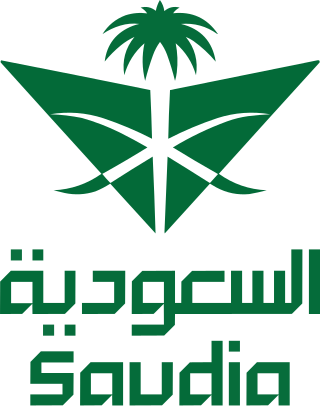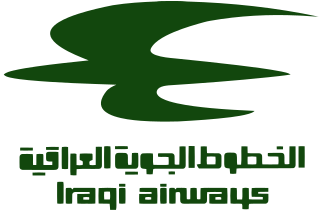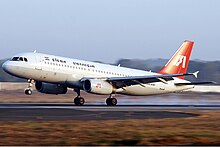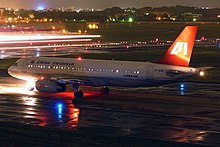
Saudia, formerly known as Saudi Arabian Airlines, is the flag carrier of Saudi Arabia, based in Jeddah. The airline's main hub is at King Abdulaziz International Airport in Jeddah and King Khalid International Airport in Riyadh, with it planning to pull out of Riyadh as a major hub by 2030.
Air Malta, stylized as airmalta, was a Maltese airline headquartered in Luqa and based at Malta International Airport. It operated services as the country's flag carrier to destinations in Europe, the Middle East and North Africa.

Iraqi Airways Company, operating as Iraqi Airways, is the national carrier of Iraq, headquartered on the grounds of Baghdad International Airport in Baghdad. It is the second oldest airline in the Middle East. Iraqi Airways operates domestic and regional services; its main base is Baghdad International Airport.
Pakistan International Airlines is an international airline which is the government-owned flag carrier of Pakistan. Its primary hub is Karachi's Jinnah International Airport, while Allama Iqbal International Airport in Lahore and Islamabad International Airport serve as secondary hubs.
All Nippon Airways Co., Ltd. is a Japanese airline headquartered in Minato, Tokyo. ANA operates services to both domestic and international destinations and is Japan's largest airline, ahead of its main rival flag carrier Japan Airlines. As of April 2023, the airline has approximately 12,800 employees. The airline joined as a Star Alliance member in October 1999.

Gulf Air is the flag carrier of Bahrain, which was founded in 1950 by British pilot Freddie Bosworth as Gulf Aviation. Headquartered in Muharraq, the airline operates scheduled flights to 59 destinations in 28 countries across Africa, Asia, and Europe. The airline's main hub is at Bahrain International Airport.
Jet Airways (India) Limited, trading as Jet Airways, was an Indian airline based in Delhi, with a training and developmental centre in Mumbai. Incorporated in April 1992 as a limited liability company, the airline began operations as an air taxi operator in 1993. It began full-fledged operations in 1995 with international flights added in 2004. The airline went public in 2005 and in 2007, when it acquired Air Sahara. The airline is expected to re-commence its flight operations by the end of 2024, making it the first Indian airline to be revived after ceasing operations.
Nepal Airlines Corporation, formerly known as Royal Nepal Airlines, is the flag carrier of Nepal. Founded in 1958, it is the oldest airline of the country. Out of its main base at Tribhuvan International Airport, Kathmandu, the airline operates domestic services within Nepal and medium-haul services in Asia. The airline's first aircraft was a Douglas DC-3, used to serve domestic routes and a handful of destinations in India. The airline acquired its first jet aircraft, Boeing 727s, in 1972. As of February 2023, the airline operates a fleet of six aircraft. Since 2013, the airline has been on the list of air carriers banned in the European Union.
PT Lion Mentari Airlines, operating as Lion Air, is an Indonesian low-cost airline based in Jakarta. Lion Air is the country's largest privately run airline, the second largest low-cost airline in Southeast Asia and the largest airline of Indonesia. With Wings Air and Batik Air, Lion Group is the country's largest airline's group. The airline operates domestic as well as international routes, which connects different destinations of Indonesia to Singapore, the Philippines, Malaysia, Thailand, Australia, India, Japan and Saudi Arabia, as well as charter routes to Mainland China, Hong Kong, South Korea and Macau, with more than 630 flights per day.

Tigerair Mandala was a low-cost carrier headquartered in Jakarta, Indonesia. It was founded in 1969 as a full service airline by members of the Indonesian military. In 2006, as part of the ongoing reforms, the military was forced to sell Mandala Airlines, with the new owners converting it to a low-cost carrier. In January 2011, facing bankruptcy, Mandala Airlines filed for protection from its creditors, and ceased operations. In May 2011, Singapore based Tiger Airways Holdings made an offer to purchase Mandala, but the transaction did not close until September 2011. The airline did not return to service until April 2012, renamed Tigerair Mandala, following an injection of fresh capital by Indonesian conglomerate Saratoga Investment Corp.
Yemenia is the flag carrier of Yemen, based in Sanaa. It operates scheduled domestic and international passenger flights to destinations in Africa and the Middle East out of its hubs at Aden International Airport, and to a lesser extent Seiyun Airport.

Indian Airlines Flight 605 was a scheduled domestic passenger flight from Bombay to Bangalore. On 14 February 1990, an Airbus A320-231 registered as VT-EPN, crashed onto a golf course while attempting to land at Bangalore, killing 92 of 146 people on board.
This is a list of aviation-related events from 2009.
Air India is the flag carrier airline of India. It is owned by Air India Limited, a Tata Group enterprise and operates a fleet of Airbus and Boeing aircraft serving 102 domestic and international destinations. It is headquartered in Gurgaon. The airline has its main hub at Indira Gandhi International Airport, Delhi and secondary hub at Chhatrapati Shivaji Maharaj International Airport, Mumbai alongside several focus cities across India. As of July 2023, the airline is the second-largest airline in India in terms of passengers carried, after IndiGo. Air India became the 27th member of Star Alliance on 11 July 2014.















